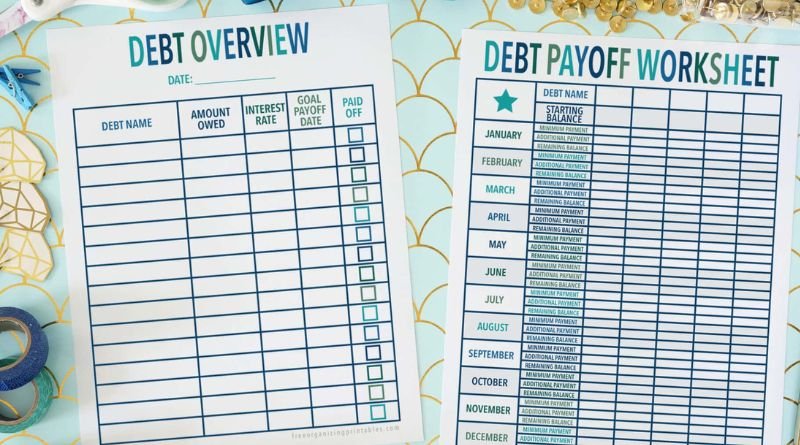Managing debt can feel overwhelming, especially if you’re juggling multiple payments or high interest rates. However, the first step to getting out of debt is understanding exactly where you stand financially and creating a plan to pay off what you owe. One of the most effective tools for tracking and managing your debt is a debt payoff worksheet. This simple yet powerful tool can help you stay organized, monitor your progress, and keep you motivated as you work toward becoming debt-free.
In this article, we’ll explore the benefits of using a debt payoff worksheet PDF, how to use it effectively, and provide helpful tips to make the most of it. Plus, we’ll answer some frequently asked questions to guide you on your debt-free journey.
Table of Contents
What is a Debt Payoff Worksheet PDF?
A debt payoff worksheet PDF is a printable document that helps you organize your debts and create a structured plan to pay them off. The worksheet typically includes columns for listing each debt, the interest rate, minimum payment, and the amount you owe, along with spaces for you to track your payments over time.
By using a debt payoff worksheet, you can:
- Get a clear overview of your financial situation
- Track your progress as you pay down each debt
- Visualize your goals, making it easier to stay motivated
- Prioritize debts based on interest rates, balances, or due dates
- Create a payment schedule that works for your budget
You can often find free printable debt payoff worksheets in PDF format, which makes them easy to download, print, and use at home. With a PDF version, you can even store it digitally, making it convenient to update and access from any device.
Why Use a Debt Payoff Worksheet?
A debt payoff worksheet helps you stay organized and focused on paying off your debt. There are several advantages to using one:
1. Clarity and Organization
It’s easy to lose track of multiple debts, especially if you’re paying down credit cards, student loans, car loans, or medical bills. A worksheet allows you to visually organize everything in one place, making it easier to see where you stand financially and how much you need to pay.
2. Create a Payment Strategy
A debt payoff worksheet helps you develop a payment strategy, such as the debt snowball or debt avalanche method. You can decide whether to prioritize paying off smaller debts first or tackle the high-interest debts to save more money over time.
3. Track Your Progress
Tracking your payments and seeing the balances decrease month after month is a great motivator. A debt payoff worksheet allows you to visually monitor your progress and celebrate small victories along the way.
4. Budgeting Help
By inputting your monthly income and expenses, the worksheet can also help you develop a budget that ensures you’re setting aside enough money to make your debt payments on time. You’ll get a clearer picture of your cash flow, which can help you adjust your spending and savings goals.
How to Use a Debt Payoff Worksheet
Using a debt payoff worksheet is simple and straightforward. Here’s a step-by-step guide to getting started:
Step 1: List Your Debts
Start by listing all of your debts. This includes credit card balances, loans, medical bills, or any other money you owe. For each debt, include the following information:
- Creditor Name: The name of the lender or company you owe money to
- Total Balance: How much you owe
- Interest Rate: The interest rate charged on each debt
- Minimum Payment: The required minimum monthly payment for each debt
- Due Date: The date each payment is due
This step gives you a comprehensive overview of your debt situation, making it easier to develop a repayment strategy.
Step 2: Choose Your Repayment Strategy
Once you have all of your debts listed, choose a repayment strategy that fits your financial goals. Here are two popular options:
- Debt Snowball Method: Focus on paying off your smallest debt first while making minimum payments on larger debts. Once the smallest debt is paid off, move on to the next smallest. This method can help build momentum and provide psychological motivation as you pay off each debt.
- Debt Avalanche Method: Focus on paying off your highest-interest debt first while making minimum payments on the others. Once the high-interest debt is paid off, move on to the next highest interest rate. This method saves you the most money in the long run by minimizing interest payments.
Step 3: Set Realistic Payment Goals
Use the worksheet to calculate how much you can realistically afford to pay toward your debts each month. Adjust your budget accordingly to prioritize debt payments, while ensuring you still have enough to cover essentials like housing, food, and transportation.
Step 4: Track Your Payments
As you make payments, update the worksheet with the new balance, payment amount, and any additional progress. This helps you stay on track and see how close you are to becoming debt-free. The act of seeing your balances decrease is motivating and reinforces your commitment to paying off your debts.
Step 5: Celebrate Milestones
Every time you pay off a debt, celebrate the milestone! This is a huge achievement and a step closer to your financial freedom. Whether you’re paying off a small credit card balance or a student loan, take time to acknowledge your hard work and keep the momentum going.
Where to Find Free Printable Debt Payoff Worksheets
There are many online resources that offer free downloadable debt payoff worksheets in PDF format. Some trusted websites include:
- NerdWallet: Offers a comprehensive debt payoff worksheet template that’s easy to use and customizable.
- Dave Ramsey: Provides worksheets as part of his “Financial Peace University” program, focusing on debt reduction strategies like the debt snowball method.
- Mint: Mint, a popular budgeting tool, has a variety of resources, including debt payoff planners, to help you manage your finances.
- Google Search: Simply search for “free printable debt payoff worksheet PDF” and you’ll find numerous downloadable templates, many of which are customizable for your needs.
These worksheets are usually simple to fill out and can be printed or saved on your device for easy access.
Tips for Staying Motivated While Paying Off Debt
Getting out of debt is a long-term commitment, and staying motivated can sometimes be challenging. Here are some tips to help you stay focused on your goals:
1. Set Clear and Achievable Goals
Start with small goals and gradually work toward larger ones. For example, your first goal might be to pay off one credit card, then move on to the next. Achieving smaller goals along the way can keep you motivated.
2. Automate Payments
If possible, set up automatic payments to ensure that your debts are paid on time. This reduces the risk of missing payments and accumulating late fees.
3. Reward Yourself
For every milestone you achieve—whether it’s paying off a small debt or making an extra payment—reward yourself with something small that makes you feel good. It’s important to acknowledge your hard work and maintain a positive mindset.
4. Stay Accountable
Share your debt payoff journey with a trusted friend or family member who can help hold you accountable. You can also join online forums or support groups where others are working toward similar financial goals.
5. Adjust Your Budget
If your income increases or you reduce your expenses, consider increasing your monthly debt payments. This will help you pay off your debts faster and reduce the total amount of interest you’ll pay in the long run.
FAQs About Debt Payoff Worksheets
1. Do I need to pay for a debt payoff worksheet?
No! There are many free resources available online to download debt payoff worksheets in PDF format. You can print them or keep them digitally on your device.
2. How do I know which repayment method to choose?
It depends on your preference. The debt snowball method works well for people who want quick wins and motivation from paying off smaller debts first, while the debt avalanche method is best for those looking to minimize interest and pay off high-interest debts first.
3. Can I use a debt payoff worksheet if I have student loans or mortgages?
Yes, you can include any debts—credit cards, student loans, mortgages, medical bills, etc.—on your debt payoff worksheet. Simply list them along with their interest rates and monthly payments, and start planning your repayment strategy.
4. Can a debt payoff worksheet help improve my credit score?
While a debt payoff worksheet doesn’t directly improve your credit score, it can help you manage your payments better. By reducing your debt and paying on time, you’ll improve your credit utilization rate and potentially boost your score over time.
5. How often should I update my debt payoff worksheet?
You should update your debt payoff worksheet whenever you make a payment, receive a statement, or if there are any changes to your debt balances or interest rates. Regular updates will help you stay organized and on track.
Conclusion
A free printable debt payoff worksheet PDF is an incredibly useful tool for anyone working to pay off debt. It helps you stay organized, track your progress, and stay motivated throughout your financial journey. By taking control of your debt and following a clear plan, you’ll be well on your way to financial freedom. Whether you’re tackling small credit card balances or larger loans, using a debt payoff worksheet can help you reach your goal of becoming debt-free faster and more efficiently.






